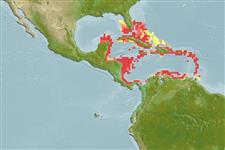Environment: milieu / climate zone / depth range / distribution range
Ecology
Marine; pelagic-neritic; depth range 0 - 50 m (Ref. 189). Tropical; 28°N - 7°S, 90°W - 60°W (Ref. 189)
Western Central Atlantic: southern Florida (USA), Cuba, Bahamas, Greater and Lesser Antilles, and Yucatan, Mexico to Venezuela; not in Gulf of Mexico; Trinidad south to Guianas; possibly Brazil.
Size / Weight / Age
Maturity: Lm ? range ? - ? cm
Max length : 12.2 cm SL male/unsexed; (Ref. 130066); common length : 10.0 cm TL male/unsexed; (Ref. 5217)
Dorsal spines (total): 0; Dorsal soft rays (total): 14 - 15; Anal spines: 0; Anal soft rays: 19 - 26. Somewhat compressed. Snout pointed, about 3/4 eye diameter; maxilla pointed, long, reaching to hind border of pre-operculum; walkeri-type gill cover canals. Anal fin origin below about midpoint of dorsal fin base. Anus advanced, nearer to pelvic fin tips than to anal fin origin. Silver stripe along flank with a dark line above, expanded over anal fin, about 3/4 eye diameter (Ref. 189). Back gray, top of head iridescent. Melanophores evenly scattered on back, forming a middorsal line, especially rearward (Ref. 7251).
Occurs in coastal waters, forming dense schools. Not entering the mangrove-lined lagoons of the Venezuelan mainland, but is the dominant species of the Los Roques Archipelago off Venezuela and there found as much in the lagoons as outside them. Frequently caught in mixed schools (with A. mitchilli) in the Miami area. Feeds on zooplankton. Ripe females recorded off Florida in June and July. More data needed.
Life cycle and mating behavior
Maturities | Reproduction | Spawnings | Egg(s) | Fecundities | Larvae
Spawn in school (Ref. 205).
Whitehead, P.J.P., G.J. Nelson and T. Wongratana, 1988. FAO Species Catalogue. Vol. 7. Clupeoid fishes of the world (Suborder Clupeoidei). An annotated and illustrated catalogue of the herrings, sardines, pilchards, sprats, shads, anchovies and wolf-herrings. FAO Fish. Synop. 125(7/2):305-579. Rome: FAO. (Ref. 189)
IUCN Red List Status (Ref. 130435)
Threat to humans
Harmless
Human uses
Fisheries: subsistence fisheries; bait: usually
Tools
Special reports
Download XML
Internet sources
Estimates based on models
Preferred temperature (Ref.
123201): 25.1 - 28.1, mean 27.5 °C (based on 112 cells).
Phylogenetic diversity index (Ref.
82804): PD
50 = 0.5000 [Uniqueness, from 0.5 = low to 2.0 = high].
Bayesian length-weight: a=0.00513 (0.00232 - 0.01135), b=3.14 (2.96 - 3.32), in cm total length, based on LWR estimates for this Genus-body shape (Ref.
93245).
Trophic level (Ref.
69278): 3.4 ±0.45 se; based on food items.
Resilience (Ref.
120179): High, minimum population doubling time less than 15 months (Preliminary K or Fecundity.).
Fishing Vulnerability (Ref.
59153): Low vulnerability (10 of 100).
